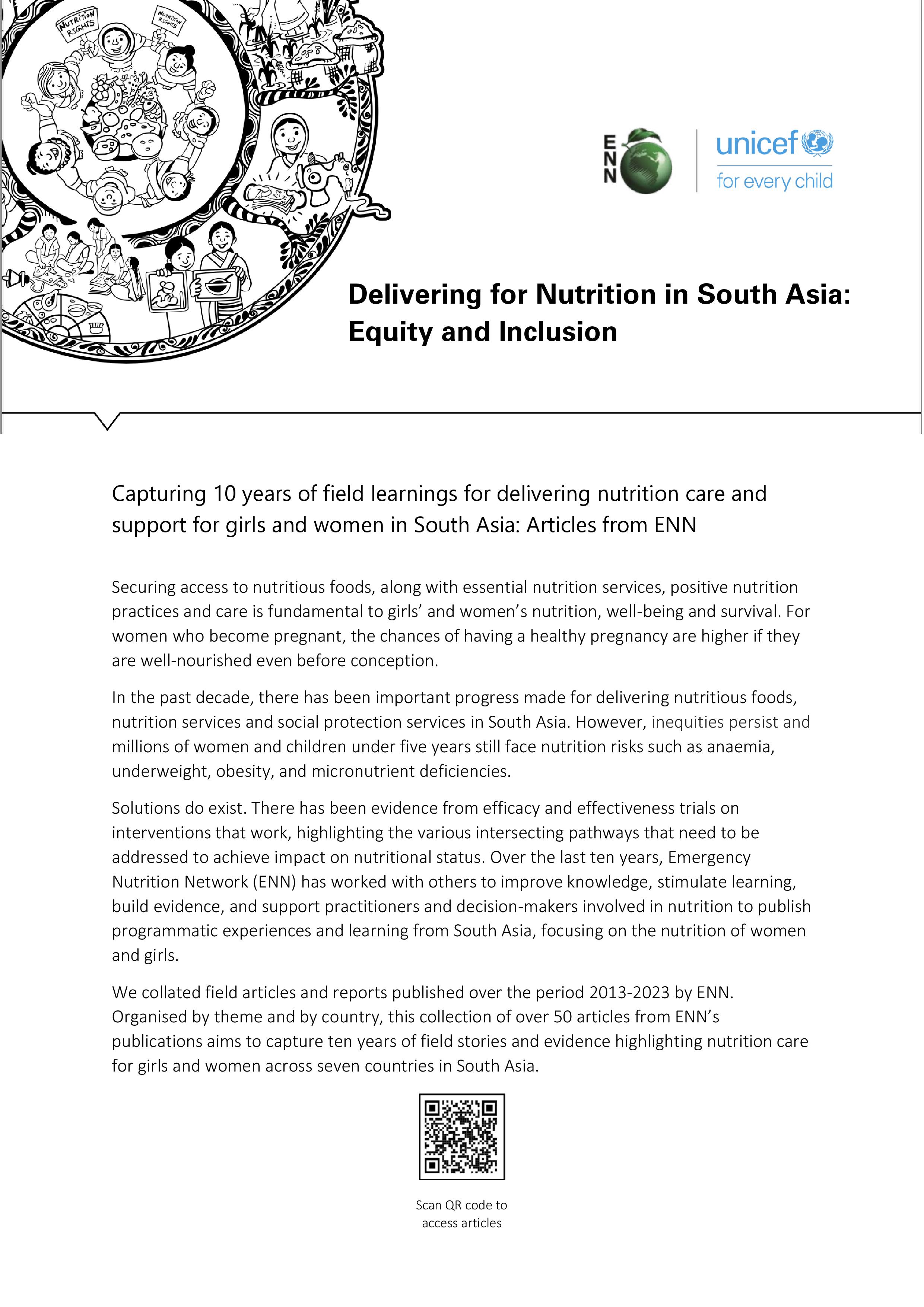Ten years of stories on implementing nutrition programmes in South Asia: Articles from ENN’s publications
Publication details
In May, the Technical Interest Group (TIG) of the ENN-facilitated Wasting and Stunting (WaSt) project1 held its bi-annual meeting, made possible through the generous support of Irish Aid and the United States Agency for International Development/Office for Foreign Disaster Assistance (USAID/OFDA). The meeting was held online over the course of two afternoons and was attended by 28 participants of the WaSt TIG (now 42 members). The meeting aimed to present and discuss the group’s workstreams, reflect on WaSt TIG ways of working and identify potential activities for phase four of the project over the next two years.
Key areas of focus during phase three of the work, carried out over the last two years, were reflected on including:
- Continued analysis of existing data: phase two work was published (for example, the analysis of longitudinal data from Gambia exploring the relationship between wasting and stunting), data from the published mortality cohort analysis was expanded upon to explore optimal anthropometric measures to identify children at high risk of dying and sex differences in wasting and stunting and the WaSt TIG review of the full state of the evidence on the relationship between wasting and stunting was updated.
- Influencing: a plain language policy brief drawing on the reviews and evidence built by the group was developed and, building on this, a Lancet Viewpoint paper was published complemented by a podcast and blog. Content was also provided to the Global Nutrition Report (GNR) and members of the TIG presented findings from the work at various technical fora.
- Testing of the implications of the group’s findings: initiated through the development of a WaSt Study protocol.
Findings from the mortality cohort analysis (11 cohort datasets from 11 countries between 1977 and 1997) were presented by Mark Myatt. The analysis explores optimal anthropometric measures to identify children at high risk of dying in the short term (including those with concurrent wasting and stunting). Findings suggest that previous analysis by the group, conducted on one mortality cohort from Senegal, are replicated in other contexts, i.e. that the case definition of Mid-Upper Arm Circumference (MUAC) < 115mm and/or weight for Age (WAZ) <-3 predicted all, or nearly all, deaths associated with Weight for Height (WHZ) <-3 and concurrent wasting and stunting. WAZ <-3 alone was also found to predict most of these deaths. The results are currently being written up for publication.
Jeanette Bailey presented findings of a secondary analysis of data from the ComPAS trial, examining the response to the treatment of children with a WAZ <-3 (approximately 4000 children). This analysis found that children with severe low WAZ (<-3) alone did respond to treatment and had better outcomes than children with just a severely low MUAC (<115mm) yet worse outcomes than those children in the trial with WAZ>-.
Kate Sadler presented an update of progress on the WaSt study which aims to describe and compare, at discharge from treatment and in post-discharge follow-up, the nutrition and health outcomes for children with MUAC ≥115mm and WAZ <-3 admitted to one of two treatment cohorts that vary in intensity and frequency of contact with wasting treatment service providers. Although the study protocol has been finalised, implementation plans which had progressed for a planned start this year are on hold given the current context.
Susan Thurstens presented an update on the progress of the wasting and stunting systematic review currently underway. This aims to provide an update of the review conducted by the group in 2014 by systematically exploring new evidence that has been generated in the wider literature regarding the relationship between wasting and stunting, the burden and implications of their concurrence and how they interact with each other over time.
Susan also presented her review of the male/female differences in the risk of and outcomes from undernutrition and implications for management. This has been carried out in collaboration with the WaSt TIG and has been submitted for publication.
The meeting then shifted to an interactive discussion on key work that is ongoing which could be developed further in phase four of the project and new areas of interest/priority for the group. Each participant had the opportunity to add their ideas to a Google document and the group discussed these. Ideas broadly related to the further dissemination of key findings, opportunities and requirements for further influencing future change at research programme and policy level, filling remaining research gaps (including via sharing the learning from the group with other research initiatives) and further translating evidence into practice. The ideas explored by the collective will be developed into a formal workplan in the coming months and shared.
The meeting closed with a heartfelt farewell to Carmel Dolan who has expertly co-coordinated the group, together with Tanya Khara, from its inception and who has made a huge contribution to its success. The group are very pleased that Carmel will continue to engage as an independent member of the WaSt TIG.
Capturing 10 years of learnings in South Asia: Articles from ENN
 |
 |
November 1-2, 2023 Document
| September 18-20, 2023 |
Join our network to generate, share and use knowledge in South Asia!
 |  |  |
| Generate and share experiences from your own programmes | Use technical assistance | Influence nutrition agenda |
| Write up your experiences and lessons learned fex@ennonline.net | Use the existing technical assistance mechanisms https://ta.nutritioncluster.net | Identify and pass on understudied issues/topics/regions |
| Read and share ! www.ennonline.net/subscribe | Engage in discussions with peers on en-net | Participate in the formation/coordination/convening of expert groups, e.g. join the Global Adolescent Nutrition Network |

